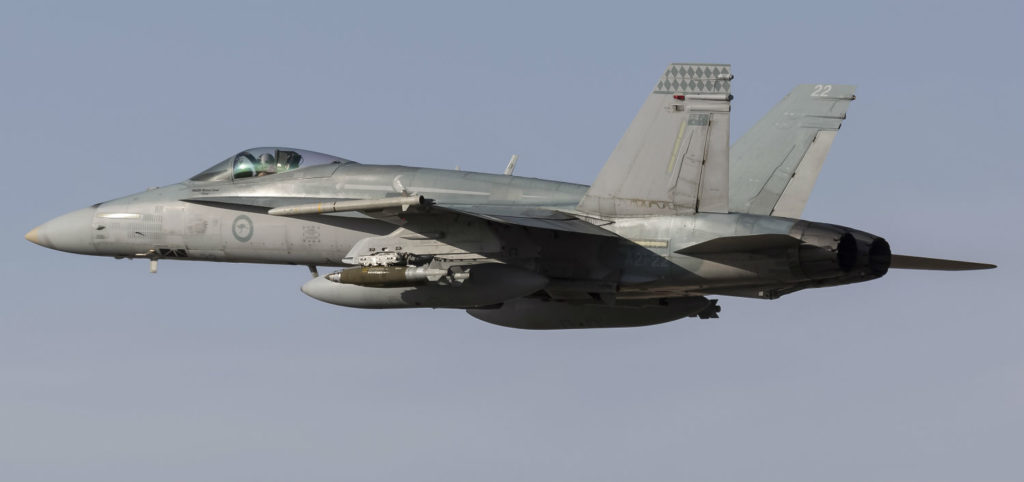Estimated reading time 6 minutes, 7 seconds.
The Canadian government is reportedly scrapping plans to buy an interim fleet of 18 new Super Hornet fighter jets from The Boeing Company.

Instead, anonymous sources familiar with the matter told the Reuters news agency that the Liberal government will purchase a used fleet of Australian F-18 jets that experts have said are “nearly identical” to Canada’s existing CF-188 Hornets.
Their similar airframes and technical specifications mean that the 30-plus-year-old Australian jets could be integrated into the Canadian fleet fairly easily. Any necessary upgrades could be performed by L3 MAS in Mirabel, Que., a maintenance, repair and overhaul (MRO) facility that has gained a global reputation as a centre of excellence in F-18 fleet management for more than 25 years.
In fact, the Royal Australian Air Force (RAAF) has already chosen L3 MAS to work on many of its legacy Hornets because the company has the unique expertise to perform centre barrel replacements, for example.
According to reports, some of the RAAF aircraft purchased will be used for parts.
Souring trade relations
A cancellation of the Super Hornet purchase–a plan announced by the Liberal government just one year ago–would come amid a climate of souring trade relations between Canada and the U.S.

First, there was anger over the trade challenge Boeing launched against Bombardier, which accused the Canadian original equipment manufacturer (OEM) of illegally dumping its C Series airliners in the U.S. market at cut rate prices. Boeing claimed Bombardier was able to do this because it was receiving unfair subsidies from the Canadian and Quebec governments to help it stay afloat. The complaint resulted in the U.S. Commerce Department making a preliminary decision to impose tariffs of nearly 300 per cent on C Series jets sold to U.S. airlines.
At the same time, delegates from Canada, the U.S. and Mexico have been working to renegotiate the North American Free Trade Agreement (NAFTA), which U.S. President Donald Trump believes has not done enough to protect U.S. industry.
While some progress has been made during the talks, the toughest issues have been left for last and present a formidable roadblock to achieving a new trade pact.
No measurable progress
Canada’s defence minister, Harjit Sajjan, said on Dec. 5 that he was unable to confirm the Australian F-18 purchase.
“I just want to reiterate we’re committed to making sure that we have a full competition,” he said. “We’re investing in the current fleet and we are going to be filling that interim gap. When the time is right, we will make sure to announce it to all Canadians.”

When pressed, Sajjan remained cagey about when the decision on an interim fighter fleet would be announced, saying only that it would be at the “appropriate time.”
Meanwhile, there are concerns that the older Australian jets are facing airframe corrosion issues and it unclear how much maintenance will be required to equip them for Canadian missions.
According to a CBC report on Oct. 16, 2017, Canada may get only five to seven years of service from each Australian jet. And by 2025, “operating in contested airspace will be very dangerous with the classic Hornet fleet as it is now,” Peter Layton, a fellow at Griffith University in South East Queensland, Australia, told the news outlet.
Sajjan was asked on Dec. 6 if he was concerned about the age of the Australian jets.
“We do a thorough, very thorough analysis on–for any options that we take,” he said. “Right now, no decision has been made. We’re going through the proper analysis to making sure that we have the right options so that we can fill this capability gap.”
Although Sajjan has said the government will hold a fair and open competition to choose Canada’s next fighter jet, there appears to be no measurable progress in that direction.
This begs the question: What in the world is the government waiting for?
– with files from Ken Pole









I am normally not one for turning every issue into a political finger-pointing exercise but this is a shameful turn of events orchestrated by this government. There is a track record of carelessness by Liberal governments pertaining to military procurement going back to Sea King helicopters, useless submarines and now the fighter replacement file.
Our service men and women deserve better than this.
You could leave the word “liberal” out of your answer and be just as accurate. Conservative governments have done no better.
Cheyenne II said it so right, our service men and women deserve better than this. Since the damn beginning of the Hornet’s replacement program, it has been a real freako show at almost every possible angle. Just forget the kind of clowns that who are in the political seats (liberal, conservative whatsoever), the point is exactly the same, the result will be the same. Now this said, why in the hell taking old worned out aussie’s hornets instead of a few brand new ones from the factory ? Recycled Armed Forces, yep more and more certainly.
It’s all about bang for the buck. That’s especially true with military equipment.